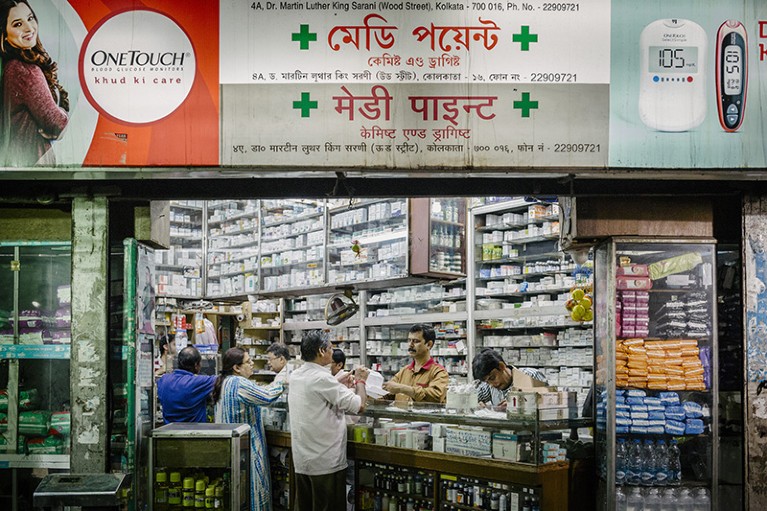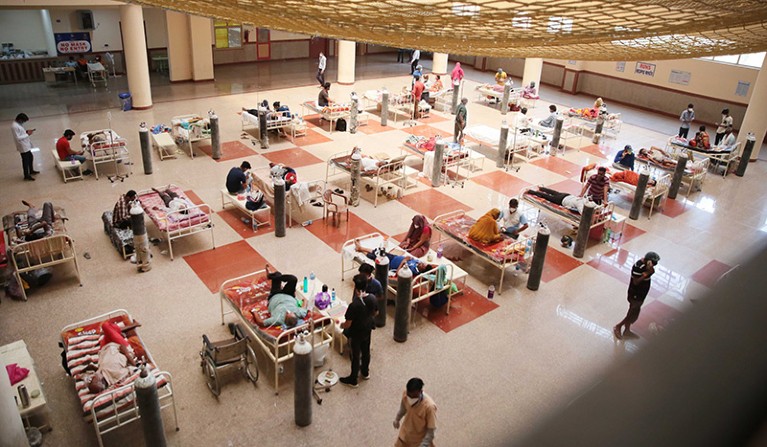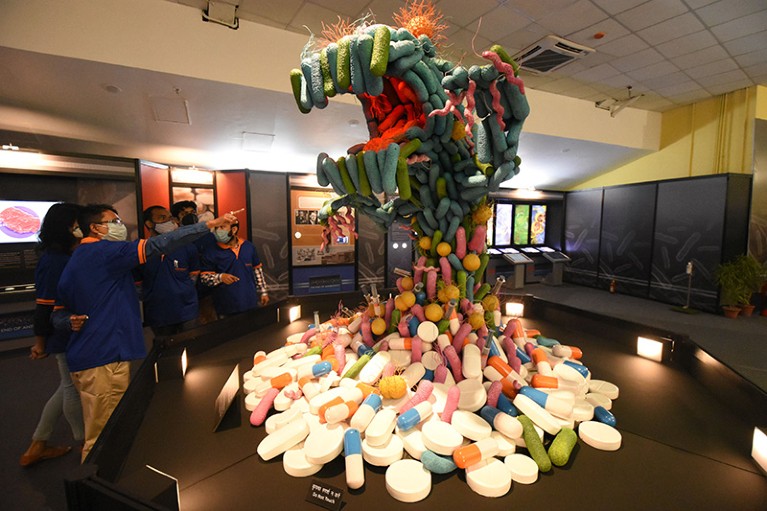
Customers have plenty of choice at a well-stocked pharmacy in Kolkata.Credit: Ian Teh/Panos
Faced with a skyrocketing rate of antimicrobial resistance, which is estimated to cause or contribute to millions of deaths around the world each year, the World Health Organization (WHO) in 2017 created a classification system for antimicrobial drugs.
The WHO’s system, AWaRe, places all available antimicrobials into three categories: access, watch and reserve. Access is for highly targeted compounds that are relatively unlikely to contribute to antimicrobial resistance, so these should be the most accessible and widely used. Watch is for those that should be used more sparingly and for patients who are the most sick, because they have a greater likelihood of contributing to the emergence of resistance in bacteria. Reserve is for antibiotics of last resort that are meant to be used only in severe, multidrug-resistant infection, when all other options have been exhausted.
In India, however, the rate at which those in the access group are used has been declining relative to the broad-spectrum ones in the watch and reserve groups, which are often prescribed inappropriately. In 2019, just 27% of prescribed antibiotic doses came from the access category, compared with about 55% from the watch list.
India is a global hotspot of antimicrobial resistance. It is home to 1.4 billion people, which is nearly 18% of the world’s population, and many of them live in poverty. It has a booming but sometimes poorly regulated pharmaceutical industry and a public–private divide in health care that has created simultaneously both excessive use of antibiotics and limited access to them.
Antibiotic-resistant infections are estimated to have directly killed nearly 300,000 people in India — including tens of thousands of newborn babies — in 2019 alone, and been a factor in a further one million deaths that year.
The problem is likely to have been exacerbated by the COVID-19 pandemic and the inappropriate use of antibiotics to combat a viral infection against which they are utterly ineffective — a phenomenon that occurred both in India and elsewhere.
“The pandemic did see the deprioritization of antimicrobial stewardship efforts everywhere,” says Kamini Walia, a microbiologist at the Indian Council of Medical Research in New Delhi. “In the absence of a more specific treatment for COVID, I think everyone was popping antibiotics.”
A 2021 study co-authored by Walia looked at people in hospital with COVID-19 who experienced bacterial or fungal infections in addition to their infection with SARS-CoV-2. The study found that more than 92% of cases of bacterial infection with Acinetobacter baumannii, which causes pneumonia, urinary-tract infections and sepsis, were resistant to carbapenem antibiotics, which are in the watch class1. “With these kinds of infections, you have very limited options to treat these patients, so that is a cause of worry,” Walia says.
Another bacterial pathogen causing concern is Staphylococcus aureus — often called golden staph — which causes a range of diseases. Up to 47% of S. aureus infections in India are resistant to methicillin2, which is an access-class antibiotic. Unfortunately, bacteria with resistance to methicillin are also resistant to several other important antibiotic classes, including penicillin and the carbapenems.
Taking steps
The Indian government has long been aware of the risk that antimicrobial resistance poses to its citizens. Its 2017 National Health Policy3 singled out antimicrobial resistance as an issue and highlighted the need for “pharmacovigilance including prescription audit inclusive of antibiotic usage, in the hospital and community”. Shortly afterwards, the Indian government launched its National Action Plan on Antimicrobial Resistance, which identified six priorities to combat antimicrobial resistance, including education, training, surveillance and improved infection control.
An important part of India’s response since then has been the establishment of antimicrobial-stewardship programmes in hospitals as part of an accreditation process, Walia says. These programmes include training hospital staff in responsible antibiotic use, testing for resistance before giving antibiotics, implementing guidelines, monitoring antibiotic prescribing levels and patterns, and tracking levels of antibiotic resistance.

The lobby of a hospital in Rajasthan became an emergency COVID-19 ward in 2021.Credit: Himanshu Vyas/Hindustan Times/Shutterstock
“Wherever there are accreditations in place, there’s an antimicrobial stewardship committee in place, and there are doctors who are aware they have to keep the antibiotic microbial pressure low,” Walia says. “Those hospitals are doing well.” For example, a study by Walia and colleagues4 found that hospitals that implemented antimicrobial stewardship programmes were able to restrict the use of broad-spectrum antimicrobials, which are more likely to lead to resistance developing, and audit programmes on antimicrobial use.
But away from specialist-care hospitals, the situation is worse, particularly in rural areas. “Suboptimal investments in health have impacted the availability of doctors, trained staff and good-quality laboratories in rural areas,” Walia says. A doctor working in those hospitals might not have the luxury of laboratory facilities to test patient samples and determine whether antibiotics are needed, and if they are, which type to prescribe for that particular infection. “So how do you guide them to practise responsible antibiotic prescription in these settings?”
Pressure to prescribe
India’s booming pharmaceutical sector — currently worth an estimated US$41 billion — is a major contributor to the problem of antimicrobial resistance. Pharmaceuticals are an important export business for India, as well as supplying the domestic market, and the industry has become adept at marketing.
“There’s so much competition in the antibiotics space that there’s aggressive pressure to sell antibiotics,” says economist and epidemiologist Ramanan Laxminarayan, director of the Center for Disease Dynamics, Economics & Policy in Washington DC. “The incentives there are to hugely oversell antibiotics, and not any antibiotic — it’s to oversell the newest antibiotics, which really shouldn’t be given to people just willy-nilly, but that’s what’s happening.”
The pharmaceutical sector has become more involved in medical education, says public-health researcher Shaffi Fazaludeen Koya at Boston University in Massachusetts, who studied in Kerala. “The continuing-education programmes are supported by the pharmaceutical industry in India,” says Koya. “I would say there is always this soft push in prescriptions; sometimes there are really hard incentives given to the doctors to push.”
This is becoming a problem with fixed-dose combinations, in which fixed doses of two antibiotics are combined in a single product — these are a particular feature of India’s antibiotics-manufacturing sector. Some fixed-dose antibiotic combinations are vitally important in treating diseases such as leprosy and tuberculosis. But the fixed doses create a risk of either under-dosing or over-dosing, both of which create conditions for resistance to emerge, and there are concerns about their increasing development and use. Koya’s research found that around one-third of all antibiotic doses consumed in India in 2019 were fixed-dose combination products, and nearly 23% of these were not approved by India’s national drug-approval authority5.
The problem for drug regulation in India is that state-based drug regulatory authorities can approve medications for marketing and use in their state even if the product has not been approved by the Central Drugs Standard Control Organization, India’s national drug regulatory organization.

An exhibition called Superbugs — the End of Antibiotics? makes a point in Kolkata.Credit: Biswarup Ganguly/Pacific Press/Shutterstock
This problem is gradually being addressed, Laxminarayan says. “The regulation previously was agnostic to irrational combinations of antibiotics — you could sell any kind of fixed-dose combination,” he says. “Now that’s no longer possible. They made it compulsory to have the combinations themselves registered.”
The pharmaceutical sector also has problems with quality, particularly at the low-cost end of the market, in which competition for profits is fierce. India is not alone in having difficulties with substandard manufacturing — an estimated 10% of medical products in low- and middle-income countries are of poor quality — but the sheer size of the sector makes it an important issue. Antibiotics that contain less than the labelled amount of active ingredients, or that are contaminated with other ingredients, also contribute to the problem of resistance, Laxminarayan says. The Indian government is working to address this, announcing a deadline of 6–12 months for all pharmaceutical manufacturers in India to upgrade their operations to meet WHO standards for good manufacturing practice.
Sujith Chandy, a pharmacologist and director of the International Centre for Antimicrobial Resistance Solutions — an independent international research and knowledge centre in Copenhagen — says the Indian government is now investing more resources in pharmaceutical regulation. In the past two decades, the number of staff working in drug control, both at the national headquarters and in the states, has greatly increased, and many of the staff are highly qualified and have extensive experience, Chandy says. But he acknowledges that the quality of drug regulation varies considerably from state to state.
Community awareness
There is also a gradual increase in awareness of the scale and nature of the antimicrobial-resistance problem in the general population. India’s socioeconomic challenges mean that the poorest patients are less likely to be able to afford the laboratory testing that would give them a more targeted, effective antibiotic treatment. Even if they can, they might not be able to afford to complete a full course, or they might buy a cheaper product or a lower dose than recommended.
“Widescale community engagement is essential at all levels,” Koya says. He is encouraged by an announcement in August this year by the state of Kerala supporting the creation of antimicrobial-resistance committees at the village level to raise awareness in the local area. “The panchayats, which are the village elected bodies, formed these committees to look into how this awareness happens, what the level of awareness is and how much people know about this,” Koya says. It will also look at conducting local audits of antibiotic prescriptions.
Despite the huge scale of the problem, those working on the ground are optimistic that change is happening to improve the situation. “I don’t think we can use the word ‘conquer’ — we can probably contain the problem,” Chandy says. He adds that as the effects of antimicrobial resistance start to be felt more widely, India is turning the tide of individual and collective motivation.
The COVID pandemic, for all its devastation, has raised the profile of antibiotic resistance and perhaps given it greater momentum than it might otherwise have had. “It may be a spark for something bigger in the next few years,” Chandy says. “We have to make sure that the spark is not extinguished but actually becomes a flame.”


 India’s year in science
India’s year in science
 Where science meets Indian economics: in five charts
Where science meets Indian economics: in five charts
 Renewable energy for the subcontinent
Renewable energy for the subcontinent
 We need to talk about water
We need to talk about water
 The climate disaster strikes: what the data say
The climate disaster strikes: what the data say
 I predict solar storms
I predict solar storms
 How high-impact papers from Indian researchers are shaping science
How high-impact papers from Indian researchers are shaping science
 India struggles to turn science into societal benefits
India struggles to turn science into societal benefits
 Big ideas: India’s drive to stem the brain drain
Big ideas: India’s drive to stem the brain drain
 I study depression in the lab and advocate for mental health in academia
I study depression in the lab and advocate for mental health in academia







